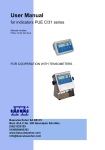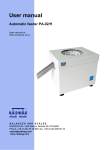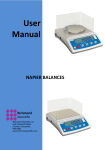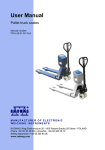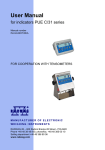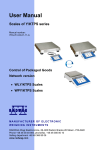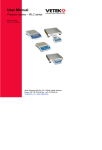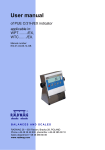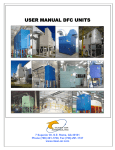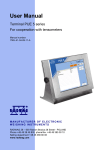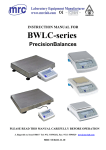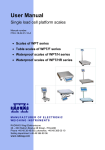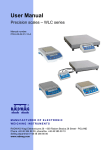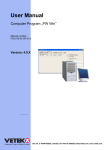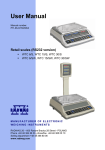Download Manual instruction
Transcript
User Manual of Postal scales Manual number: ITKU-20-02-01-12-A MANUFACTURER OF ELECTRONIC WEIGHING INSTRUMENTS RADWAG Wagi Elektroniczne 26 – 600 Radom Bracka 28 Street - POLAND Phone +48 48 38 48 800, phone/fax. +48 48 385 00 10 Selling department +48 48 366 80 06 www.radwag.com JANUARY 2012 -2- TABLE OF CONTENTS 1. INTENDED USE .................................................................................................................... 5 2. PRECAUTIONS..................................................................................................................... 5 2.1. Maintenance................................................................................................................... 5 2.2. Accumulator / battery pack............................................................................................. 5 2.2.1. Power supply of weighing indicators in plastic casings ....................................... 6 2.2.2. Replacement of worn batteries............................................................................ 7 2.3. Operation in a strong electrostatic field.......................................................................... 8 3. WARRANTY CONDITIONS................................................................................................... 8 4. MAIN DIMENSIONS .............................................................................................................. 9 5. UNPACKING AND ASSEMBLY.......................................................................................... 10 5.1. Scales of WPT/P 2 series ............................................................................................ 10 5.2. Scales of WPT/P 60 series .......................................................................................... 11 6. GETTING STARTED ........................................................................................................... 12 7. KEYPAD .............................................................................................................................. 13 8. KEYS’ FUNCTIONS ........................................................................................................... 13 9. INSCRIPTIONS ON THE DISPLAY .................................................................................... 14 10. USER MENU ..................................................................................................................... 14 10.1. Submenus ................................................................................................................. 14 10.2. Browsing user menu .................................................................................................. 15 10.2.1. Keypad ............................................................................................................ 15 10.2.2. Return to the weighing mode .......................................................................... 15 11. WEIGHING ........................................................................................................................ 16 11.1. Tarring ....................................................................................................................... 17 11.2. Inscribing tare value .................................................................................................. 17 11.3. Zeroing ...................................................................................................................... 18 11.4. Weighings in two ranges ........................................................................................... 18 11.5. Selection of basic weight unit .................................................................................... 19 11.6. Temporarily selected unit .......................................................................................... 20 12. MAIN PARAMETERS ........................................................................................................ 21 12.1. Setting a filtering level ............................................................................................... 21 12.2. Median filter ............................................................................................................... 22 12.3. Autozero function....................................................................................................... 23 12.4. Tare function.............................................................................................................. 24 13. RS 232 PARAMETERS ..................................................................................................... 25 13.1. Baud rate ................................................................................................................... 25 13.2. Minimal mass threshold............................................................................................. 26 14. OTHER PARAMETERS .................................................................................................... 26 14.1. Backlight function ...................................................................................................... 27 14.1.1. Backlight for supplying from mains.................................................................. 27 14.1.2. Backlight for supplying from batteries ............................................................. 28 14.2. “Beep” signal – after pressing a key .......................................................................... 28 14.3. Automatic switch-off .................................................................................................. 29 14.4. Battery voltage level check........................................................................................ 30 14.4.1. Checking the batteries..................................................................................... 30 14.4.2. Battery discharge pictogram............................................................................ 31 14.4.3. Accumulator charging option ........................................................................... 31 14.4.4. Formatting rechargeable battery packs ........................................................... 32 -3- 15. USER CALIBRATION ....................................................................................................... 33 15.1. Calibration ................................................................................................................. 33 15.2. Start mass adjustment............................................................................................... 35 16. COOPERATION WITH PRINTER ..................................................................................... 36 17. COOPERATION WITH COMPUTER................................................................................. 37 18. COMMUNICATION PROTOCOL ...................................................................................... 38 18.1. General information ................................................................................................... 38 18.2. A set of commands for RS interfaces ........................................................................ 38 18.3. Respond message format ......................................................................................... 39 18.4. Command’s description ............................................................................................. 39 18.4.1. Zeroing ............................................................................................................ 39 18.4.2. Tarring ............................................................................................................. 39 18.4.3. Get tare value .................................................................................................. 40 18.4.4. Send the stable result in basic unit.................................................................. 40 18.4.5. Send the result immediately in basic unit ........................................................ 41 18.4.6. Send the stable result in current unit ............................................................... 41 18.4.7. Send the result immediately in current unit ..................................................... 42 18.4.8. Switch on continuous transmission in basic unit ............................................. 43 18.4.9. Switch off continuous transmission in basic unit ............................................. 43 18.4.10. Switch on continuous transmission in current unit........................................ 43 18.4.11. Switch off continuous transmission in current unit........................................ 44 18.4.12. Send all implemented commands................................................................. 44 18.5. Manual printouts ........................................................................................................ 44 18.6. Continuous transmission ........................................................................................... 45 18.7. Configuring printouts ................................................................................................. 45 19. ERROR COMMANDS........................................................................................................ 46 20. TECHNICAL PARAMETERS ............................................................................................ 46 21. TROUBLE SHOOTING ..................................................................................................... 47 22. ADDITIONAL EQUIPMENT............................................................................................... 47 -4- 1. INTENDED USE Platform scales are designed for fast and precise measurements of weighed loads masses and direct commercial settlements. Tarring in full weighing range enables to determine net mass of weighed loads. Additional display is additional equipment of scale. It is to control mass of weighed load by another person. Functions: • • • • • • • • • • • backlight of display level of filtration median filter autozero function setting baud rate of transmission designation minimum mass for function operating automatic tare memory of tare inscribing tare value automatic scale switch-off user calibration 2. PRECAUTIONS 2.1. Maintenance A. Please, read carefully this user manual before and use the device according to its intended use. B. Devices that are to be withdrawn from usage should be sent back to the producer or in case of own utilization do it according to the law. 2.2. Accumulator / battery pack Scales aquipped with indicator PUE C/31 (plastic casing) are devices designed to be supplied from NiMH batteries (nickel-metal-hydrogen) with rated voltage of 1.2V, size R6 and capacities from 1800 to 2800mAh charged while connected to mains without stopping operation. -5- The device connected to mains inteligently monitors the battery state and charges it if possible. After sudden lack of power supply from the mains the device automatically switches to accumulator without breaking operation. In case of an elongated storage period in low temperatures, it is not allowed the full discharge of the accompanied batteries. The equipment including accumulators does not belong to your regular household waste. The European legislation requires that electric and electronic equipment be collected and disposed separately from other communal waste with the aim of being recycled. Notice: Some symbols on accumulators identify harmful elements/compounds: Pb = lead, Cd = cadmium, Hg = mercury. 2.2.1. Power supply of weighing indicators in plastic casings Indicators in plastic casing are intended to be supplied from a power adapter or from NiMH rechargeable battery pack (standard equipment). New rechargeable batteries should be formatted according to the description in the chapter 14.4.4. of this manual. Alternatively, you can use to power the device R6 size standard nonrechargible batteries. If you want to use normal batteries instead of rechargeable ones, proceed as follows: • • Before installing non-rechargeable batteries turn on the device and set <5.5.CHr6> to <no>, to switch off charging. Then install the batteries. Installing batteries without changing <5.5.CHr6> to <no> may cause damage of batteries and the indicator. -6- 2.2.2. Replacement of worn batteries Users have the ability to replace worn out batteries to new ones in weighing indicators PUE C/31 (plastic casing). Procedure: • Open the lid of the chamber for batteries placed in the bottom of the indicator casing: • Remove discharged and then insert new batteries into the chamber, according to given polarity (+/-): • Close the lid of the chamber for batteries: -7- In PUE C/31H and PUE C/31H/Z weighing indicators (stainless steel housing) the worn out accumulator can be exchanged to a new one by the authorized service of the manufacturer. 2.3. Operation in a strong electrostatic field If the device is about to operate in a strong electrostatic field (e.g. printing houses etc.) it should be connected to the earthing. Connect it to the clamp terminal signed . 3. WARRANTY CONDITIONS A. RADWAG is obliged to repair or change those elements that appears to be faulty because of production and construction reason, B. Defining defects of unclear origin and outlining methods of elimination can be settled only in participation of a user and the manufacturer representatives, C. RADWAG does not take any responsibility connected with destructions or losses derives from non-authorized or inappropriate (not adequate to manuals) production or service procedures, D. Warranty does not cover: • Mechanical failures caused by inappropriate maintenance of the device or failures of thermal or chemical origin or caused by atmospheric discharge, overvoltage in mains or other random event, • Inappropriate cleaning. E. Loss of warranty appears after: • Access by an unauthorized service, • Intrusion into mechanical or electronic construction of unauthorized people, • Removing or destroying protection stickers. F. The detailed warranty conditions one can find in warranty certificate. -8- G. Contact with the central authorized service: +48 48 384 88 00 ext. 106 or 107. 4. MAIN DIMENSIONS Scales of WPT/P 2 series Scales of WPT/P 60 series -9- 5. UNPACKING AND ASSEMBLY 5.1. Scales of WPT/P 2 series Unpack and put the scale on a flat even stable surface far away from sources of heat and then: • Remove transport protection: • Set the pillar with additional display vertically: • Screw down the pillar to the scale basis: • Turn the display head: - 10 - 5.2. Scales of WPT/P 60 series Unpack and put the scale on a flat even stable surface far away from sources of heat and then: A. Remove transport protection: B. To attach the pillar to the scale body: • Screw down the pillar handler to the platform: • Stretch delicately the cable so it did not touch the ground after mounting: - 11 - • The surplus cable wind and place inside the pillar as show below: Put the indicator with the hendler on the pillar and tighten up the handwheels: 6. GETTING STARTED • After unpacking and mounting the scale level it out. Use levelling legs and the level condition indicator installed in the basis of the scale. • Turn the device on using the for about 0.5 sec, • Wait for the test completion, key – keep pressing the key - 12 - • Then you will see zero indication and pictograms: - zero indication - stable result kg - weight unit • If the indication is not zero press key. 7. KEYPAD 8. KEYS’ FUNCTIONS Switching on/off Function key (operation mode selection) Sending a weighing result to RS232 Zeroing Tarring Notice: + keys’ functions changes. The way of operation After pressing in this mode is described in details further in this manual. - 13 - 9. INSCRIPTIONS ON THE DISPLAY No Text string Description 1. FIL Filter level 2. bAud Transmission baud rate 3. Auto Autozero correction 4. t1 Power save – time to switch off while no operation 5. Indication in autozero zone (indication = exact zero) 6. Stable result (ready to read) 7. Operation mode – weighing kg (g) Rechargeable battery pack or battery discharged (BAT-LO) 8. 9. Tare function has been used. Net 10. USER MENU 10.1. Submenus User’s menu is divided into 5 basic submenus. Each group has its own characteristic name preceded by the letter P and a number. P1 rEAd P 1.1 P 1.2 P 1.3 P 1.4 P2 Prnt P2.2 P2.3 P3 Unit P3.1 P5 othr P5.1 P5.2 P5.3 P5.4 P5.5 P6 CAL P6.1 P6.2 Fil Auto tArA Fnnd | | | | 2 YES no no S_Lo bAud | | 9600 StUn | kg bL bLbt bEEP t1 CHr6 | | | | | Auto 70 YES Auto YES St_u uCAL | | * FUNKCJA * * FUNKCJA * - 14 - 10.2. Browsing user menu Use scale’s keys to move inside the menu. 10.2.1. Keypad Entering main menu + + Inscribing tare value Increasing a digit value by „1” moving down in the menu Battery / accumulator state monitoring + Toggling between gross / net values + Selecting the parameter or changing the value of a selected parameter Entering the selected submenu or activating a parameter for changes Confirmation (enter) Leaving without changes or reaching a higher level of the menu 10.2.2. Return to the weighing mode The changes that have been introduced should be saved in order to keep them in the memory for good. While leaving parameters press key until the text <SAuE?> appears on the display. Then press: – to save changes or – to leave without changes. - 15 - 11. WEIGHING Put a load you want to weigh on the weighing pan. When the pictogram appears it means that the result is stable and ready to read. In order to assure long-term operation and appropriate measurements of weighted loads following precautions should be taken into consideration: • Loads should be placed on the pan delicately and carefully in order to avoid mechanical shocks: • Loads should be placed centrally on the pan (errors caused by eccentric weighing are outlined by standard PN-EN 45501 ch. 3.5 and 3.6.2): • Do not load the pan with concentrated force: • Avoid side loads, particularly side shocks should be avoided - 16 - 11.1. Tarring In order to determine the net mass put the packaging on the pan. (Net pictogram will be displayed in the left After stabilising press upper corner and zero will be indicated). After placing a load on the weight pan net mass will be shown. Tarring is possible within the whole range of the scale. After unloading the pan the display shows the tarred value with minus sign. Notice: Tarring cannot be performer when a negative or zero value is being displayed. In such case Err3 appears on the display and short audible signal will be emitted. 11.2. Inscribing tare value You can also inscribe a tare value. While in weighings mode press: • Press simultaneously • You will see : and - 17 - , • Using • • , Press Program returns to weighings mode. The inscribed tare value can be seen on the display with „–” sign, Tare can be inscribed anytime in weighings mode. • and set the tare value, Notice: You cannot inscribe a new tare value when the tare value in memory is greater than zero. In the case of trying this the <Err3> message will be displayed and short audible signal will be emitted. 11.3. Zeroing To ZERO the scale press: . The scale will display zero and following pictograms: and Zeroing is only possible within the scope of ±2% of full scale. While zeroing outside the scope of ±2% you will see Err2. Zeroing is possible only in stable state. . Notice: Zeroing is possible only within the ±2% interval of the maximal range. If zeroing is performed beyond this range the <Err2> message and short audible signal will be emitted. 11.4. Weighings in two ranges Switching between the I range and the II range happens automatically (exceeding Max of the I range). Weighings in the second range is signalled by a pictogram in the top left corner of the display. Then weighings is done with the accuracy of the II range to the moment ) where the scale switches back of returning to zero (autozero range to the I range. - 18 - 11.5. Selection of basic weight unit This function is used to set weight unit the scale will start with. Procedure: • Enter the submenu <P3.Unit> and then: • press , until the expected unit appears on the display: Options: A. When the basic unit is [kg], users can toggle between: [kg, lb, N],for verified scales [lb] is not accessible, B. If the basic unit is [g], users can toggle between: [g, ct, lb], for verified scales [lb] is not accessible, - 19 - • After you select the unit press , the scale returns to: • Return to weighing according to chapter - 10.2.2. Notice: After turning on the scale always sets the basic unit. 11.6. Temporarily selected unit This function is used to set weight unit the scale will use temporarily until the next power off or next selection. Procedure: • Press and then: • After you select the unit you want come back to weighing procedure. - 20 - Options: A. When [kg] is a basic unit, users can select following units: [kg, lb, N], [lb] is not accessible for verified scales. B. When [g] is a basic unit, users can select following units: [g, ct, lb], [lb] is not accessible for verified scales. 12. MAIN PARAMETERS Users can adjust the scale to external ambient conditions (filtering level) or particular needs (autozero operation, tare memory). This parameters are placed in <P1.rEAd> submenu. 12.1. Setting a filtering level Procedure: • Enter the submenu <P1.rEAd> and then: 1 - 4 - level of filtering • By pressing select the filtering level you need. - 21 - Notice: Filtering level influences the time of stabilization. The higher the filtering level is the longer stabilization time is needed. Return to weighing: See - 10.2.2. 12.2. Median filter This filter eliminates short changes (impulses) of measure signal (e.g. shocks). Procedure: • Enter the submenu <P1.rEAd> and then: Fnnd Fnnd no - filter disabled YES - filter enabled Return to weighing: See - 10.2.2. - 22 - 12.3. Autozero function The autozero function has been implemented in order to assure precise indications. This function controls and corrects „0” indication. While the function is active it compares the results continuously with constant frequency. If two sequentional results differ less than the declared value of autozero range, so the scale will be automatically zeroed and will be displayed. and the pictograms When AUTOZERO is disabled zero is not corrected automatically. However, in particular cases, this function can disrupt the measurement process e.g. slow pouring of liquid or powder on the weighing pan. In this case, it is advisable to disable the autozero function. Procedure: • Enter the submenu <P1.rEAd> and then: Fnnd Fnnd no - filter disabled YES - filter enabled Return to weighing: See - 10.2.2. - 23 - 12.4. Tare function This parameters enables users to configure a tare function. Procedure: • Enter the submenu <P1.rEAd> and then: tArA AtAr - tArA tArA no tArF - automatic tare function on and is stored in balance memory after unplugging it from mains automatic tare function off tare memory function – stores last value of tare in balance memory. It is automatically displayed after starting the balance. Value of tare is displayed with minus sign, and there is Net symbol indicated on the display. Return to weighing: See - 10.2.2. - 24 - 13. RS 232 PARAMETERS External devices connected to RS 232C have to be supplied from the same mains and common electric shock protection. It prevents from appearing a potential difference between zero leads of the two devices. This notice does not apply to the devices that do not use zero leads. Transmission parameters: • • • • Baud rate - 2400 – 38400 bit / s Data bits - 8 Stop bits - 1 Parity control - no 13.1. Baud rate Procedure: • Enter the submenu <P2.Prnt> and then: Return to weighing: see 10.2.2. - 25 - 13.2. Minimal mass threshold This function is necessary while working with automatic tare. Automatic tarring will not be applied until the indication (gross) is lower than the value inscribed in S_Lo parameter. Procedure: • Enter the submenu <P2.Prnt> and then: Return to weighing: see 10.2.2. 14. OTHER PARAMETERS The user can set parameters which influence the scale operation. They are gathered in the submenu <P5.othr> e.g. backlight and beep signal. Enter this submenu <P5.othr> according to chapter 10.2. - 26 - 14.1. Backlight function Program recognises the way the scale is supplied (mains, battery) and automatically selects the way of operating on the backlight: bl blbt – for mains, – for batteries or rechargeable battery pack. 14.1.1. Backlight for supplying from mains Procedure: • Enter the submenu <P5.othr> and then: bL bL bL no YES Auto - backlight switched off backlight switched on backlight switched off automatically if indication becomes stable for about 10s Return to weighing: See 10.2.2. Notice: When bl=Auto, and the indication has not changed for 10s, the backlight is automatically switched off. The backlight is switched on again automatically after the result changes. - 27 - 14.1.2. Backlight for supplying from batteries The user can change the intensity of backlight from 0% to 100%. The lower the intensity is the longer the scale operates without recharging or exchanging batteries. When the intensity is set this function works as AUTO (described above). Procedure: • Enter the submenu <P5.othr> and then: Return to weighing: See 10.2.2. Notice: The more intense the backlight is the shorter the scale operates on batteries. 14.2. “Beep” signal – after pressing a key Procedure: • Enter the submenu <P5.othr> and then: - 28 - bEEP bEEP no - switched off YES - switched on Return to weighing: See 10.2.2. 14.3. Automatic switch-off This function is essential to save the battery power. The scale is switched off automatically when (function t1 = YES) no weighing appears in 5 minutes. (no changes on the display). In case when this function disrupts the operation (e.g. long time weighing procedures) or while working with connection to mains, switch off this function. Operation according to the power supply: Operation Setting t1 = 0 Mains Batteries/accumulator disabled disabled t1 = YES enabled enabled t1 = Auto * disabled enabled * automatic enabling/disabling according to the source of power. - 29 - Procedure: • Enter the submenu <P5.othr> and then: Returnto weighing: See 10.2.2. 14.4. Battery voltage level check While supplying from batteries too low level of voltage is measured by is displayed. It means that charging or software the pictogram exchanging batteries is required. 14.4.1. Checking the batteries This function is to check the level of battery supply. It works only if: • Weighing mode is set, • Battery supply is set in parameters. - 30 - Procedure: After displaying the level of batteries (in per cents) the program returns to weighing. 14.4.2. Battery discharge pictogram The symbol (bat low) switches on when the voltage level drops to 18% of the accepted level of voltage. It means that charging or exchanging batteries is required. Low level of batteries: • • • Pictogram on the display, After one time the device will automatically switch off to protect the batteries from distructable discharging, Charging is signalled by (blinking period about 2 seconds) on the display. 14.4.3. Accumulator charging option This function allows to switch on charging algorithm for NiMH batteries (for indicators plastic casing): a) Parameter <CHr6> set to <no>: does not appear, charging disabled, • Pictogram • During software initializing, after turning on „bAtt”. b) Parameter <CHr6> set to <YES>: • blinks slowly (period about 2 seconds), Pictogram charging is enabled, - 31 - • • Message „nImh” appears on the display, In case of damaging accumulators or lack of it the pictogram blinks quickly (period about 0.5 sec). Notice: Indicators are equipped with the set of rechargeable batteries NiMH R6 (AA) and power adapter. Procedure: • Enter the submenu <P5.othr> and then: CHr6 YES CHr6 no - enabled - disabled Return to weighing: See 10.2.2. 14.4.4. Formatting rechargeable battery packs Postal scales with indicators in plastic cases are intended to supply from power adapters (standard equipment). It is possible to supply them from NiMH AA/R6 rechargeable batteries or R6 batteries. - 32 - They need formatting after first powering up. It is crucial for batteries lifetime to undertake this process. Formatting consist in charging and total discharging (without meantime charging). Procedure: 1. 2. 3. 4. 5. Supply the indicator from mains. Charge batteries for 12 hours (time of charging 2200mAh batteries). After 12 hours unplug from mains. Use the device up to the moment of self powering down. Repeat the process of charging starting from point 1. Notice: They reach their optima capacity after three cycles of full charging and discharging. 15. USER CALIBRATION Only for non-verified scales Confirmation of high accuracy of weighing requires periodical correcting of calibration factors in the scale memory – this is adjustment of the scale. Calibration should be performed when we start weighing or dynamic change of temperature occurs. Before starting calibration remove loads from the pan. 15.1. Calibration Procedure: • Enter the submenu <P6.CAL> and then: - 33 - • Following inscriptions will appear • A new start mass is adjusted during this period of time. After that a mass of calibration weight is shown (e.g. 3 000kg). . • Put a weight of the displayed mass value on the pan and press The calibration process will start which is signalled by the message: • After completion of the process of calibration the following screen will appear: • Take off the weight , then the following sequence of screens will appear: • Calibration process can be terminated anytime by pressing which is signalled by the following message on the display: - 34 - • Return to weighing performing the procedure of saving parameters. Caution: If the calibration process (span adjustment) lasts longer than 15 the <Err8> message will be displayed and short audible signal will be to perform calibration again with more stable emitted. Press ambient conditions! 15.2. Start mass adjustment If the scale does not require the full calibration process sit is possible to adjust only a new start mass. Procedure: • Enter the submenu <P6.CAL> and then: • The display will show the following information: • After the completion of the start mass adjustment the following screen will appear: - 35 - • The process of start mass adjustment can be terminated by pressing , which is signalled on the display: • Return to weighing performing the procedure of saving parameters. Caution: If the start mass adjustment lasts longer than 15 the <Err8> message will be displayed and short audible signal will be emitted. Press calibration again with more stable ambient conditions! to perform 16. COOPERATION WITH PRINTER key is pressed a current mass value together with mass Each time the units is sent to RS 232 interface. One of thermal printer in KAFKA series can cooperate with each platform scales: a) KAFKA Only result of weighing with mass unit can be printed. b) KAFKA 1/Z This printer is equipped with an internal real time clock. Both date and time can be printed. c) KAFKA SQ S This printer is equipped with an internal real time clock and possibility of running statistics from measurements. Statistic contents: quantity of samples, sum of masses of all samples, average value, standard deviation, variation factor, min value, max value, difference max - min. - 36 - Cable diagrams: Cable drawing scale - printer (Kafka) 17. COOPERATION WITH COMPUTER Sending weighing results to the computer can be done: - manually - in continuous way - on the request from the computer - after pressing key, after sending an control command - After sending a control command These scales can cooperate with „EDYTOR WAG” program. The indicator window comprises the most important information from the scale display. The program allows to configure easily, e.g. design printouts, edit parameters. A precise description is issued in the „Help” file that accompanies the program. Cable diagrams: Cable drawing connecting scale and computer - 37 - 18. COMMUNICATION PROTOCOL 18.1. General information A. A character protocol scale-terminal has been designed for communication between RADWAG scales and external devices via RS-232 interface. B. It consists of commands sent from an external device to the scale and a responses from a scale. C. Responses are sent every time after receiving a command (reaction for any command). D. Using commands allows users to receive some information about the state of scale and/or influence the operation e.g.: • Requesting weighing results, • Display control, 18.2. A set of commands for RS interfaces Commands Description of commands Z Zeroing T Tarring TO Get tare S Send the stable result in basic unit SI Send the result immediately in basic unit SU Send the stable result in current unit SUI Send the result immediately in current unit C1 Switch on continuous transmission in basic unit C0 Switch off continuous transmission in basic unit CU1 Switch on continuous transmission in current unit CU0 Switch off continuous transmission in current unit PC Send all implemented commands Notice: 1. Each command have to be terminated in CR LF; 2. The best Policy for communication is not sending another command until the former answer has been received. - 38 - 18.3. Respond message format After sending a request message you can receive: XX_A CR LF command accepted and in progress XX_D CR LF command completed (appears only after XX_A) XX_I CR LF command comprehended but cannot be executed XX _ ^ CR LF command comprehended but time overflow error appeared XX _ v CR LF command comprehended but the indication below the XX _ OK CR LF Command done ES_CR LF Command not comprehended XX _ E CR LF error while executing command – time limit for stable result exceeded (limit time is a descriptive parameter of the scale) XX _ - command name - substitutes spaces 18.4. Command’s description 18.4.1. Zeroing Syntax Z CR LF Possible answers: Z_A CR LF Z_D CR LF - command accepted and in progress - command completed Z_A CR LF Z_^ CR LF - command accepted and in progress - command comprehended but zero range overflow appeared Z_A CR LF Z_E CR LF - command accepted and in progress - time limit for stable result exceeded Z_I CR LF - command comprehended but cannot be executed 18.4.2. Tarring Syntax: T CR LF Possible answers: - 39 - T_A CR LF T_D CR LF - command accepted and in progress - command completed T_A CR LF T_v CR LF - command accepted and in progress - command comprehended but tare range overflow appeared T_A CR LF T_E CR LF - command accepted and in progress - time limit for stable result exceeded T_I CR LF - command comprehended but cannot be executed 18.4.3. Get tare value Syntax: TO CR LF Possible answers: TO_TARA CR LF - command executed Frame format: 1 2 3 4 5-6 7-15 16 T O space stability space tare space Tare Unit 17 18 19 unit 20 21 CR LF - 9 characters with decimal point justified to the right - 3 characters justified to the left 18.4.4. Send the stable result in basic unit Syntax: S CR LF Possible answers: S_A CR LF S_E CR LF - command accepted and in progress - time limit for stable result exceeded S_I CR LF - command comprehended but cannot be executed S_A CR LF MASS FRAME - command accepted and in progress - mass value in basic unit is returned - 40 - Frame format: 1 2-3 4 5 6 7-15 16 S space stability space sign mass space 17 18 19 unit 20 21 CR LF Example: S CR LF – computer command S _ A CR LF - command accepted and in progress S _ _ _ _ - _ _ _ _ _ _ 8 . 5 _ g _ _ CR LF – command done, mass value in basic unit is returned. 18.4.5. Send the result immediately in basic unit Syntax: SI CR LF Possible answers: SI_I CR LF MASS FRAME - command comprehended but cannot be executed at the moment - mass value in basic unit is returned Frame format: 1 2 3 4 5 6 7-15 16 S I space stability space sign mass space 17 18 19 unit Example: S I CR LF – computer command S I _ ? _ _ _ _ _ _ _ 1 8 . 5 _ k g _ CR LF - command done, mass value in basic unit is returned immediately. 18.4.6. Send the stable result in current unit Syntax: SU CR LF Possible answers: - 41 - 20 21 CR LF SU_A CR LF SU_E CR LF - command accepted and in progress - timeout while waiting for stable results SU_I CR LF - command comprehended but cannot be executed SU_A CR LF MASS FRAME - command accepted and in progress - mass value in current unit is returned Frame format: 1 2 3 4 5 6 7-15 16 S U space stability space sign mass space 17 18 19 unit 20 21 CR LF Example: S U CR LF – computer command S U _ A CR LF - command accepted and in progress S U _ _ _ - _ _ 1 7 2 . 1 3 5 _ N _ _ CR LF - command done, mass value in current unit is returned. 18.4.7. Send the result immediately in current unit Syntax: SUI CR LF Possible answers: SUI_I CR LF - command comprehended but cannot be executed MASS FRAME - mass value in current unit is returned immediately Frame format: 1 2 3 4 5 6 7-15 16 S U I stability space sign mass space 17 18 19 unit Example: S U I CR LF – computer command S U I ? _ - _ _ _ 5 8 . 2 3 7 _ k g _ CR LF - command executed and mass returned - 42 - 20 21 CR LF 18.4.8. Switch on continuous transmission in basic unit Syntax: C1 CR LF Possible answers: C1_I CR LF - command comprehended but cannot be executed C1_A CR LF MASS FRAME - command comprehended and in progress - mass value in basic unit is returned Frame format: 1 2 3 4 5 6 7-15 16 S I space stability space sign mass space 17 18 19 unit 20 21 CR LF 20 21 CR LF 18.4.9. Switch off continuous transmission in basic unit Syntax: C0 CR LF Possible answers: C0_I CR LF - command comprehended but cannot be executed C0_A CR LF - command comprehended and executed 18.4.10. Switch on continuous transmission in current unit Syntax: CU1 CR LF Possible answers: CU1_I CR LF - command comprehended but cannot be executed CU1_A CR LF MASS FRAME - command comprehended and in progress - mass value in current unit is returned Frame format: 1 2 3 4 5 6 7-15 16 S U I stability space sign mass space - 43 - 17 18 unit 19 18.4.11. Switch off continuous transmission in current unit Syntax: CU0 CR LF Possible answers: CU0_I CR LF - command comprehended but cannot be executed CU0_A CR LF - command comprehended and executed 18.4.12. Send all implemented commands Syntax: PC CR LF Possible answers: PC_- >_Z,T, TO,S,SI,SU,SUI,C1,C0,CU1,CU0,PC – command executed, the indicator have sent all the implemented commands. 18.5. Manual printouts Users can general manual or automatic printouts from the scale. Manual printouts can be performed after loading the pan and stabilizing indication . by pressing Notice: If a scale is verified printouts of immediate values are blocked. Format frame: 1 2 3 4 -12 13 stability space sign mass space - 44 - 14 15 unit 16 17 18 CR LF Stability character sign mass unit command [space] if stable [?] if not stable [^] if an indication over the range [v] if fan indication below the range [space] for positive values or [-] for negative values 9 characters justified to the right 3 characters justified to the left 3 characters justified to the left Example 1: _ _ _ _ _ _ 1 8 3 2 . 0 _ g _ _ CR LF – the printout generated from the scale after pressing ENTER/PRINT. Example 2: ? _ - _ _ _ _ 2 . 2 3 7 _ l b _ CR LF - the printout generated from the scale after pressing ENTER/PRINT. Example 3: ^ _ _ _ _ _ _ 0 . 0 0 0 _ k g _ CR LF - the printout generated from the scale after pressing ENTER/PRINT. 18.6. Continuous transmission The indicator can work in a continuous transmission mode. It can be switched on using RS232 commands (see 20.4). 18.7. Configuring printouts General information If some information included are redundant or not sufficient and there is a necessity of changes one can design their own protocol format in EDYTOR WAG computer program. This piece of software is accessible in: http://www.radwag.com - 45 - 19. ERROR COMMANDS Err2 - Value beyond the zero range Err3 - Value beyond the tare range Err4 - Calibration mass or start mass beyond the acceptable range (±1% for weight, ±10 for start mass) Err8 - Exceeded the time for tarring, zeroing, start mass adjustment or span adjustment NULL - Zero value from the AD converter FULL2 - Measurement range overflow LH - Start mass error, the mass on the weighing platform is beyond the acceptable range (-5% to +15% of start mass) Notice: 1. Errors: Err2, Err3, Err4, Err8, null, that appear on the display are also signalled by a short beep sound (about 1 sec.); 2. Error FULL2 that appears on the display is also signalled by a continuous sound until the cause of error disappears. 20. TECHNICAL PARAMETERS Scale type: WPT/P 2 WPT/P 60 Max capacity 2kg 60kg Min capacity 5g 100g Reading accuracy 1g 20g Verification scale interval 1g 20g Range of tare Pan size Power supply -2kg -60kg 230 x 160mm 400 x 500mm 230V 50Hz/11V AC and 6xAA (NiMH) Temperature of work 0°C to +40°C Average operation when supplied from batteries 35 hours (average time) Display Net / Gross weight Package dimensions LCD with backlight 3,5 / 4,8kg 15,5 / 17,8kg 400 x 380 x 110mm 720 x 580 x 220mm - 46 - 21. TROUBLE SHOOTING Problem Turning on does not work The scale turns off automatically Cause Solution Discharged batteries. Connect to mains or change batteries No batteries (not installed or improperly installed) Check the correctness of installation (polarization) „t1” set to „YES” (Power save) In „othr” submenu change „5.4 t1” to „no” After turning on „LH” Loaded weight pan during message on the display powering up Unload the pan. Then the scale will indicator zero. 22. ADDITIONAL EQUIPMENT Accessories: • • • • • • • KAFKA printer cable - P0136, Computer cable - P0108, EPSON printer cable - P0151, Power cord for car lighter 12V DC - K0047, Thermal printer - KAFKA, Dot matrix printer - EPSON, Additional display in plastic casing for PUE C/31- WD- 4/1 (accessible with balance as complete set only), • RS232 / RS485 converter for PUE C/31 – KR-01, • RS232 / Ethernet converter for PUE C/31 - KR-04, Computer programs: • “EDYTOR WAG” computer program, • "RAD-KEY" computer program, • "PW-WIN" computer program. - 47 - MANUFACTURER OF ELECTRONIC WEIGHING INSTRUMENTS RADWAG WAGI ELEKTRONICZNE 26 – 600 Radom, Bracka 28 Street POLAND Tel. +48 48 38 48 800, tel./fax. + 48 48 385 00 10 Selling departament + 48 48 366 80 06 www.radwag.com - 48 -
















































